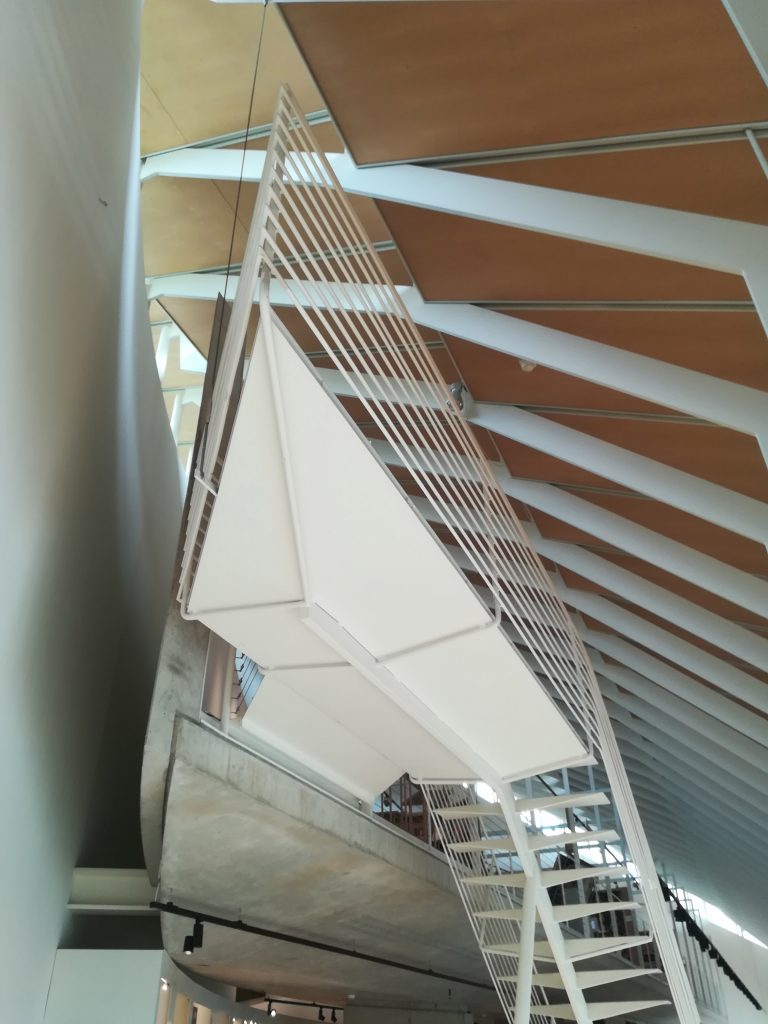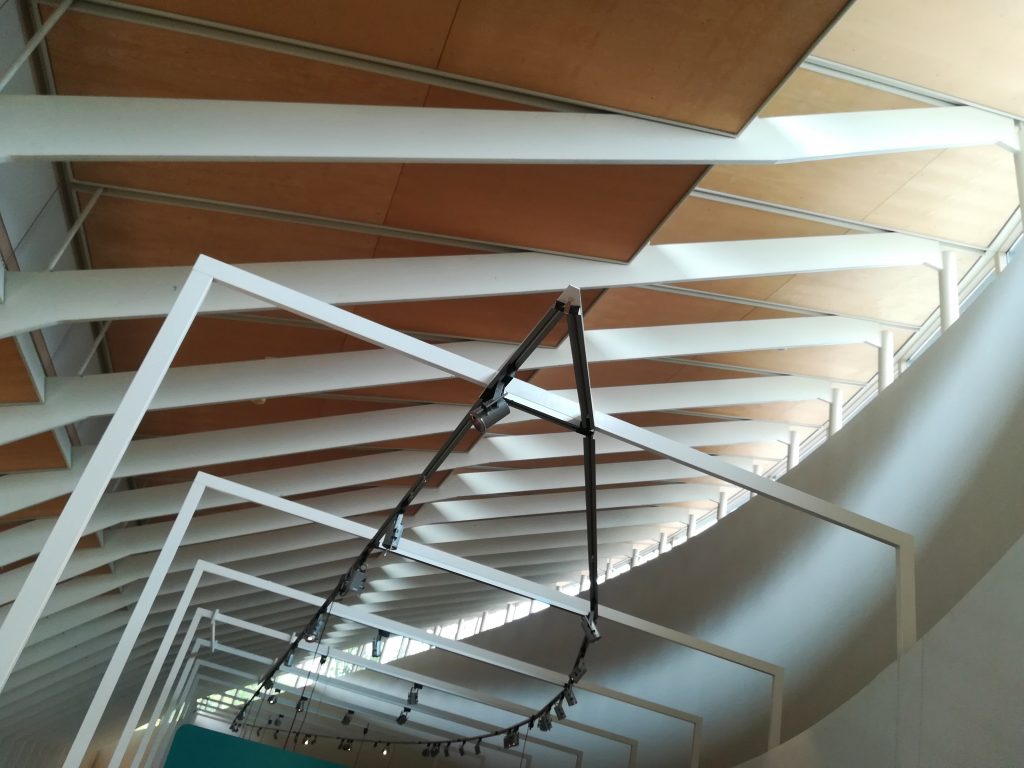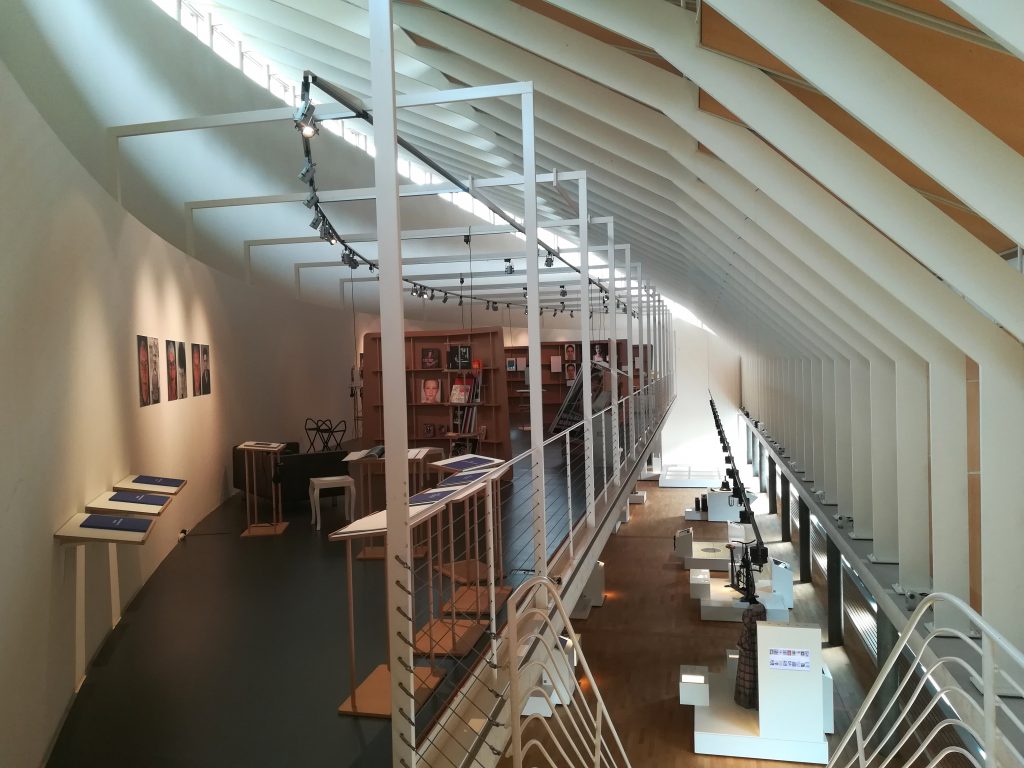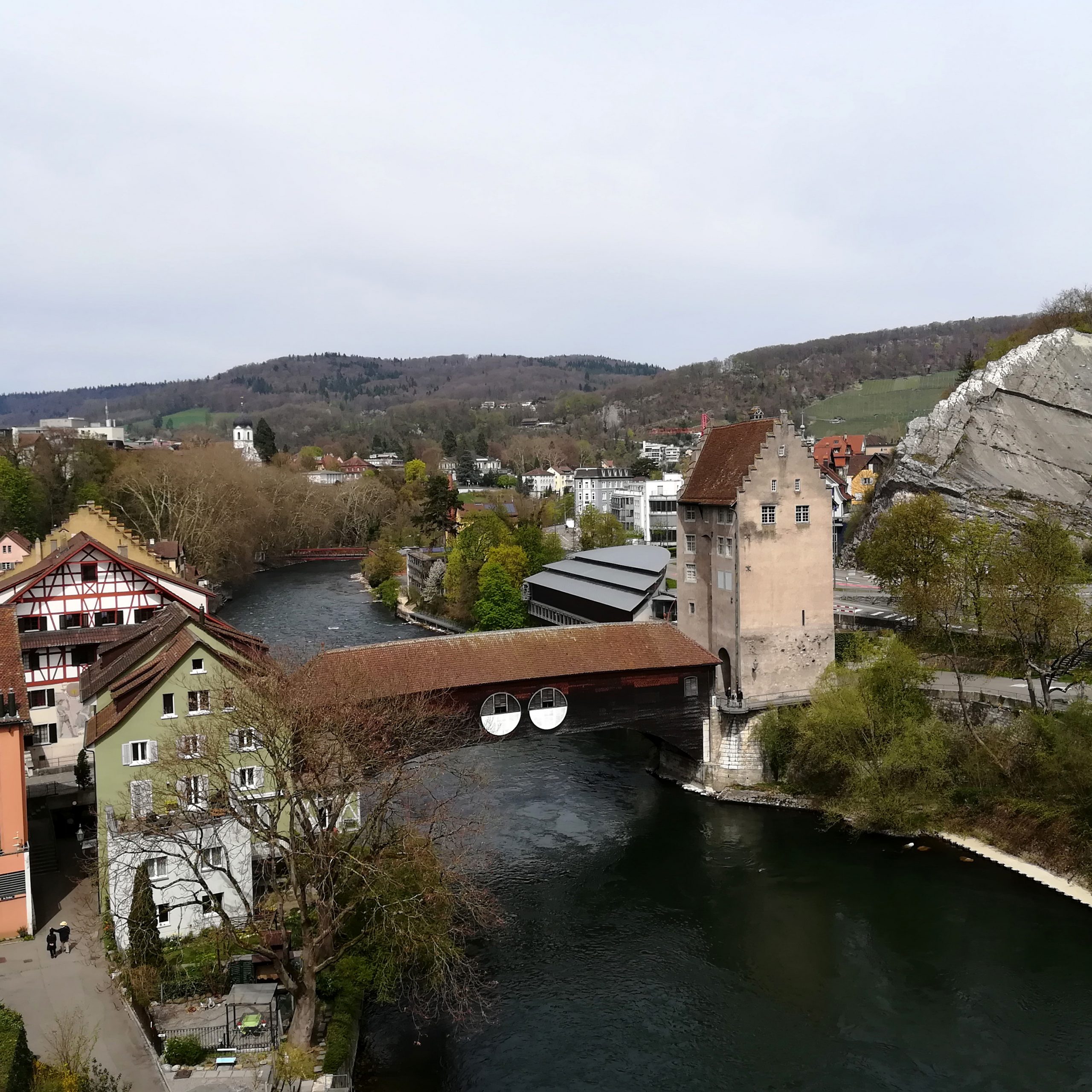This article is part of the Hidden Architecture Series “Tentative d’Épuisement”, where we explore the practice of an architectural criticism without rhetoric and based mainly on the physical experience of the work itself.
Este artículo forma parte de la serie “Tentativa de Agotamiento”, comisariada por Hidden Architecture, donde exploramos la práctica de una crítica arquitectónica ausente de retórica y fundamentada sobre todo en la experiencia física de la propia obra.
Eisenbahnweg
The atmosphere is cool and damp. It hasn’t rained all morning but, in the distance, dark clouds shiver in the wind. A group of middle-aged men talk in Italian outside the station. It’s Sunday and the city is still quietly waking up, the air freshens the lungs as we breathe in. As soon as we set foot in Baden, we recognise the importance of the Limmat river throughout its history, a nervous flow that has carved out the basin on which the urban fabric is organised.
El ambiente es fresco y húmedo. Aún no ha llovido en toda la mañana pero, a lo lejos, nubes oscuras se estremecen con el viento. Un grupo de hombres de mediana edad habla en italiano a la puerta de la estación. Es domingo y la ciudad se despereza todavía en calma; el aire refresca los pulmones al inspirar. Tan pronto ponemos el pie en Baden, se reconoce la importancia del río Limmat a lo largo de su historia, caudal nervioso que ha excavado la cuenca sobre la que se organiza el tejido urbano.
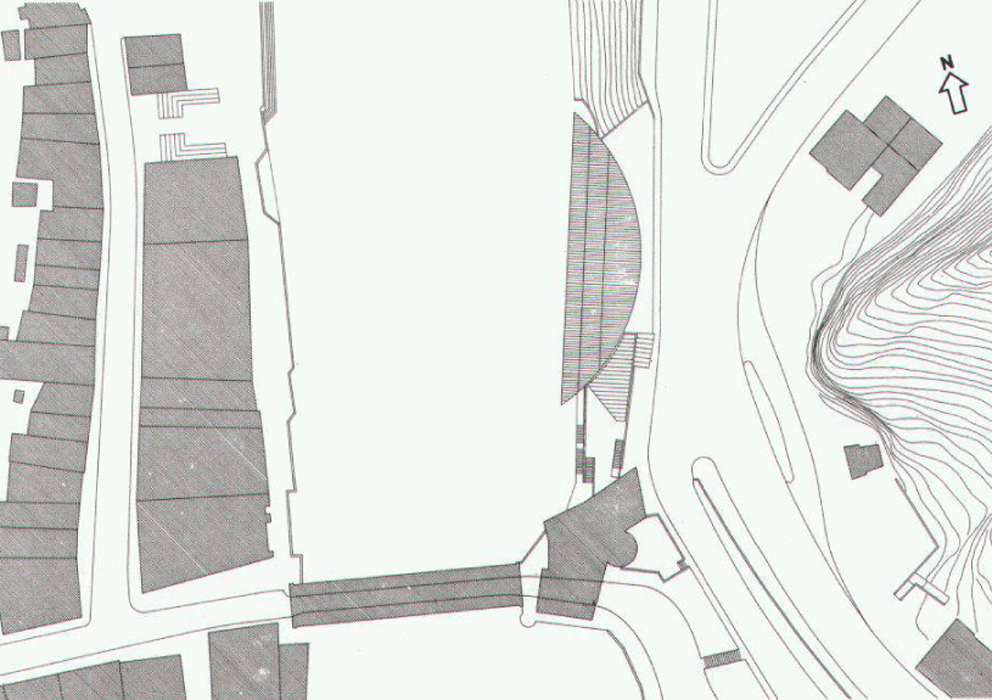
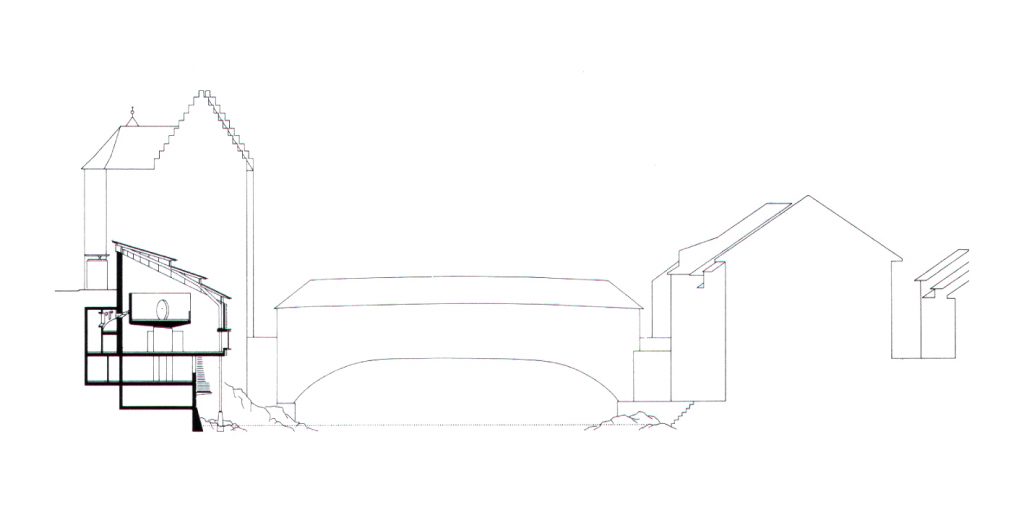
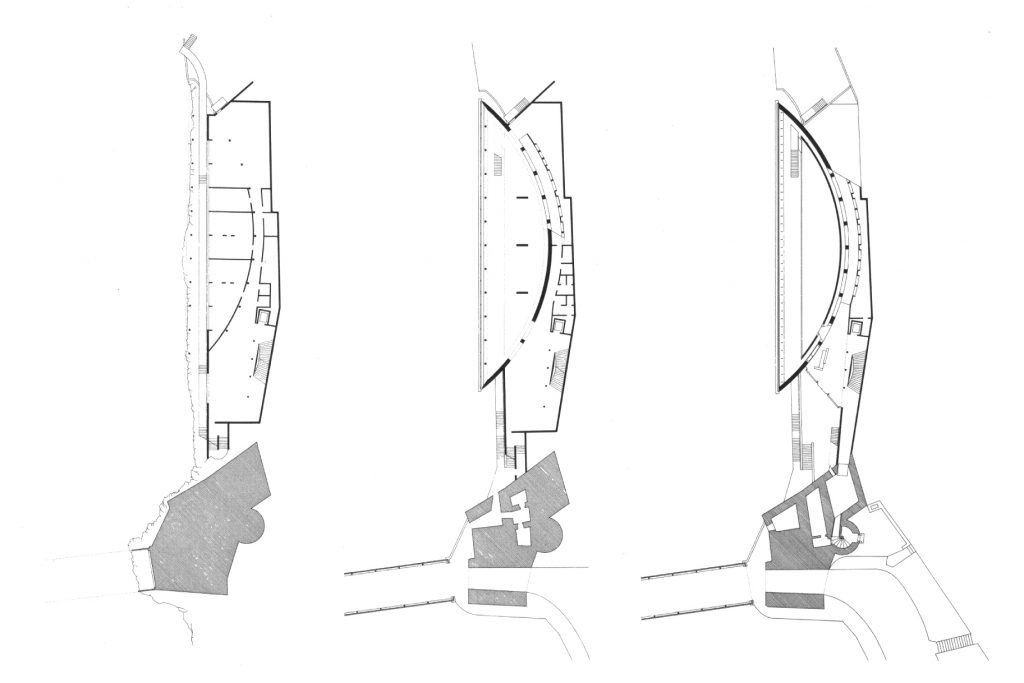
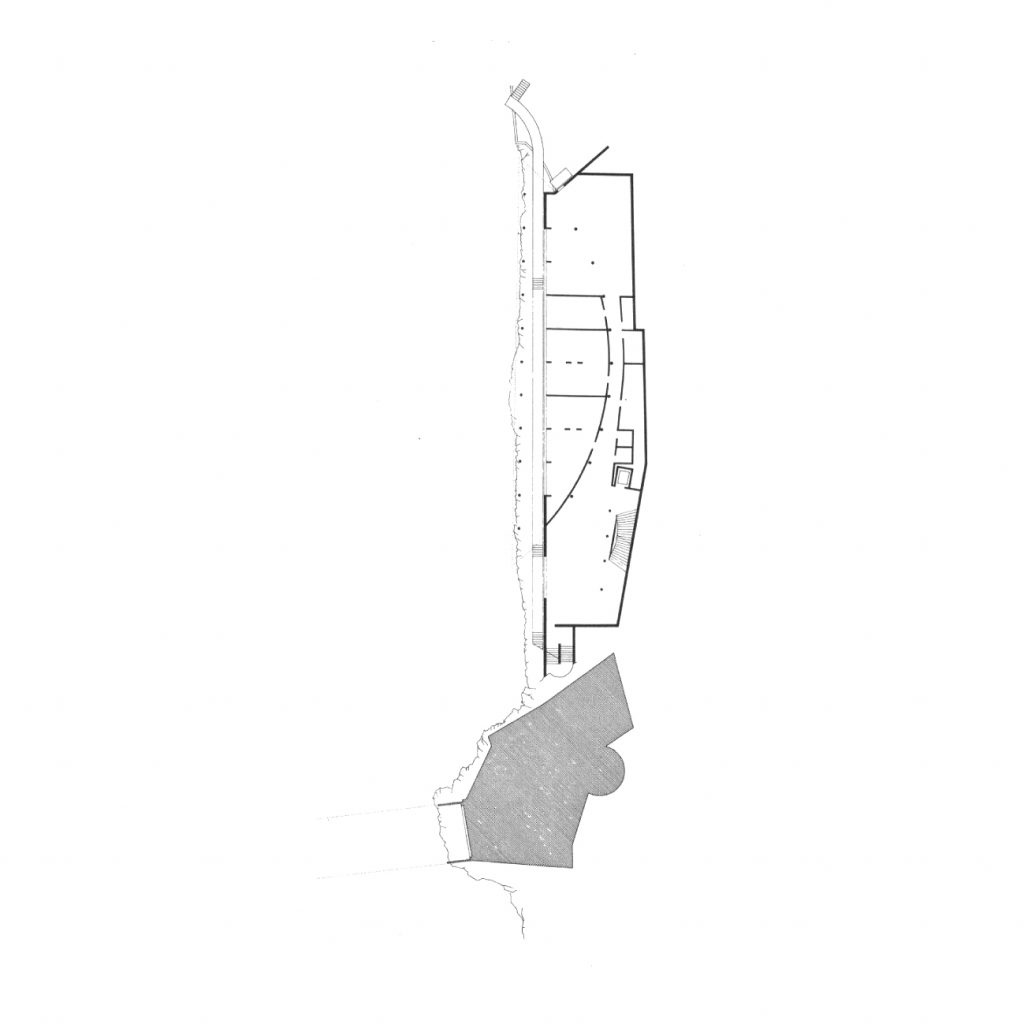
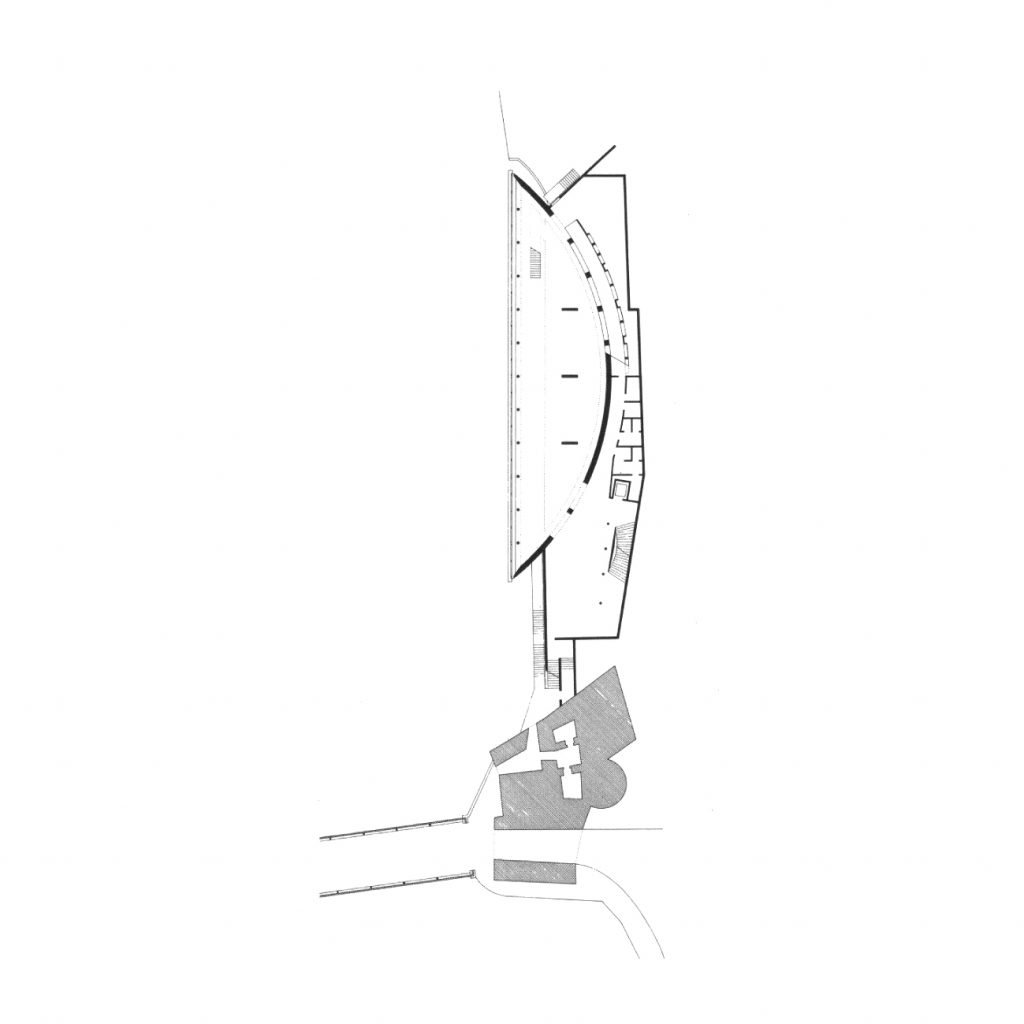
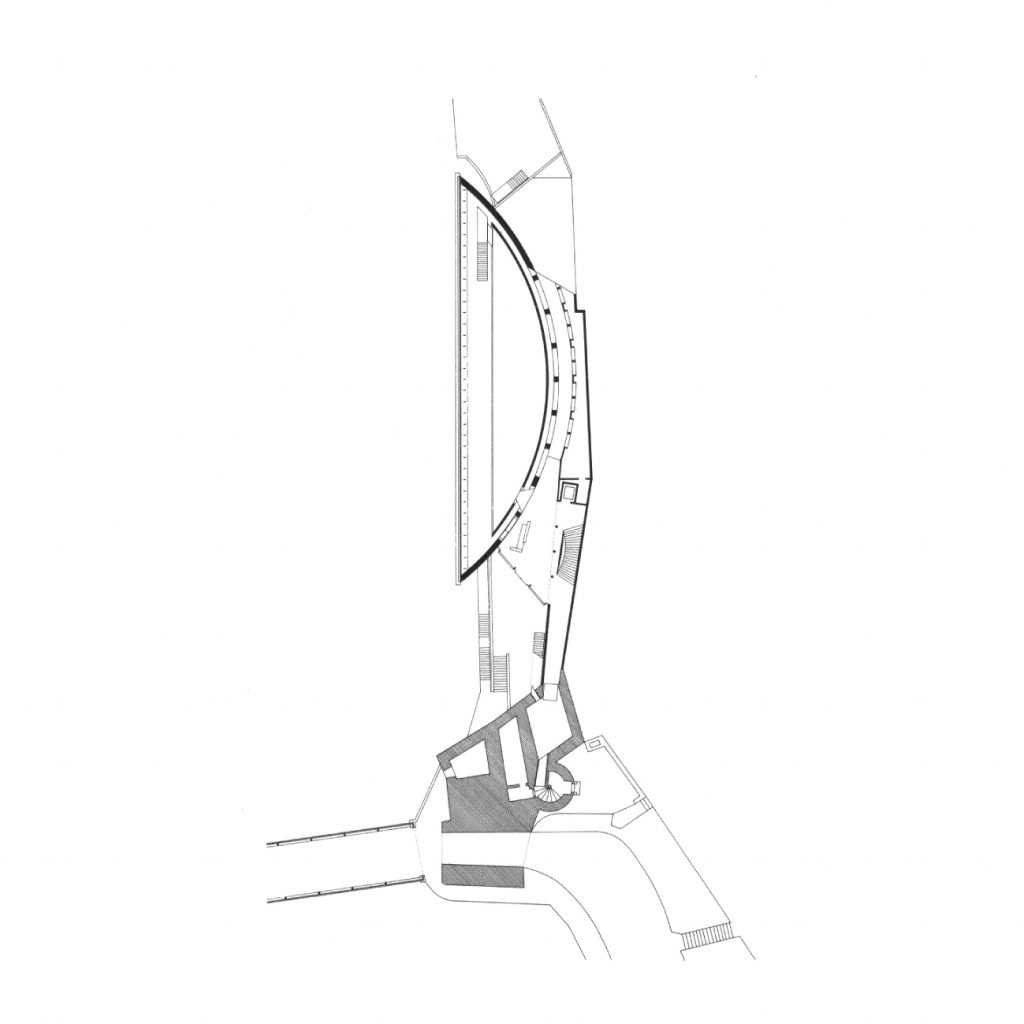
Badstrasse
A collection of nondescript buildings defines what appears to be Baden’s main thoroughfare. Shops now closed will perhaps provide some urban activity to this area. Overhead, clouds drift across the sky in a brief sigh, giving way to shy glimmers of light filtered through layers of suspended moisture. A neutral, muted sun, fleetingly ignites some glass. Following its call, more and more people come out to meet us as we move towards the centre. Four men argue, now in Portuguese, in the corner of a bakery that remains closed. Behind the rooftops, a pair of cranes sway delicately in the wind. This strange mechanical dance, on display on stormy days, emits moans of poorly greased rust into the air with each rotation. A McDonald’s restaurant opens its doors. A yellow-shirted employee, no more than sixteen years old, arranges the tables and chairs on the terrace; he squeezes and dries the water deposited on the polished chrome surfaces. Unsuspecting now, hours later hunger will press in and we will mix childhood memories with industrial tomato sauce. Beyond, a blunt corner folds as a preface to a square yet to be awakened.
Un conjunto de construcciones anodinas define lo que parece la arteria principal de Baden. Comercios ahora cerrados proporcionarán quizá cierta actividad urbana a esta zona. Sobre tu cabeza, las nubes se deslizan por el cielo en un breve suspiro, dejando paso a tímidos destellos de luz filtrados a través de capas de humedad en suspensión. Un sol neutro, apagado, enciende fugazmente algún vidrio. Siguiendo su reclamo, cada vez más personas salen a nuestro encuentro a medida que avanzamos hacia el centro. Cuatro hombres discuten, ahora en portugués, en la esquina de una panadería que permanece cerrada. Detrás de los tejados, un par de grúas oscilan delicadamente mecidas por el viento. Esta extraña danza mecánica, exhibida los días de tormenta, emite al aire quejidos de herrumbre mal engrasada en cada rotación. Un restaurante McDonald’s abre sus puertas. Un empleado de camisa amarilla, no tendrá más de dieciséis años, coloca las mesas y sillas de la terraza; escurre y seca el agua depositada sobre las pulidas superficies cromadas. Sin sospecharlo ahora, horas después el hambre apretará y mezclaremos recuerdos de infancia con salsa de tomate industrial. Más allá, una esquina roma se pliega como prefacio de una plaza también por despertar.
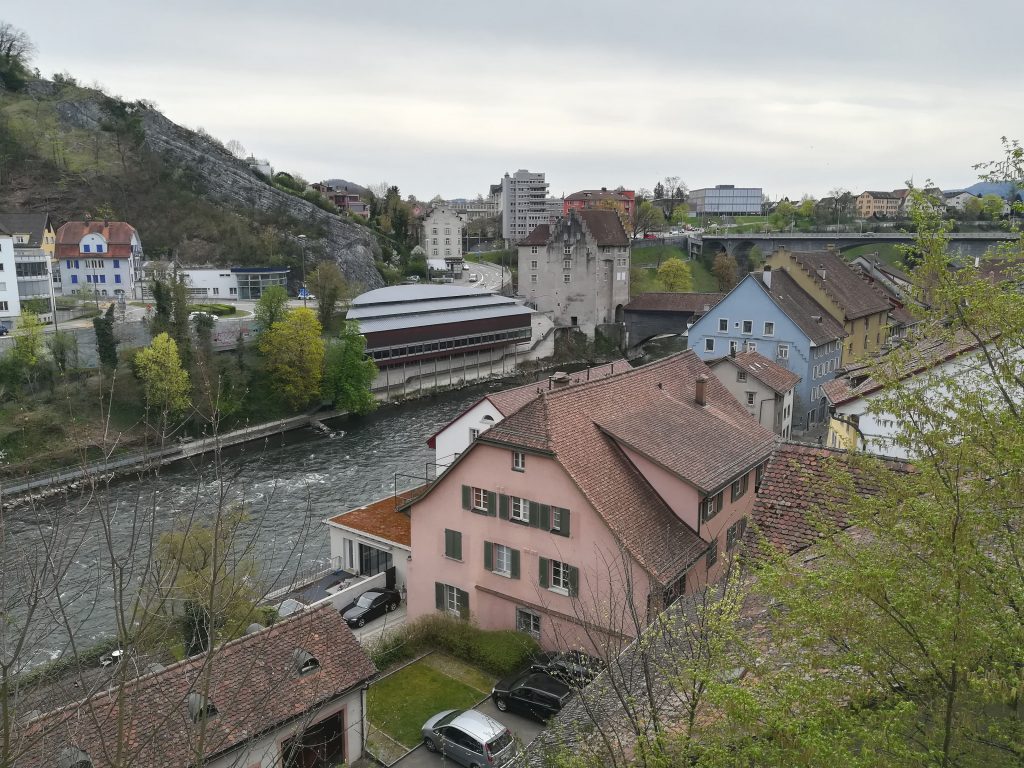
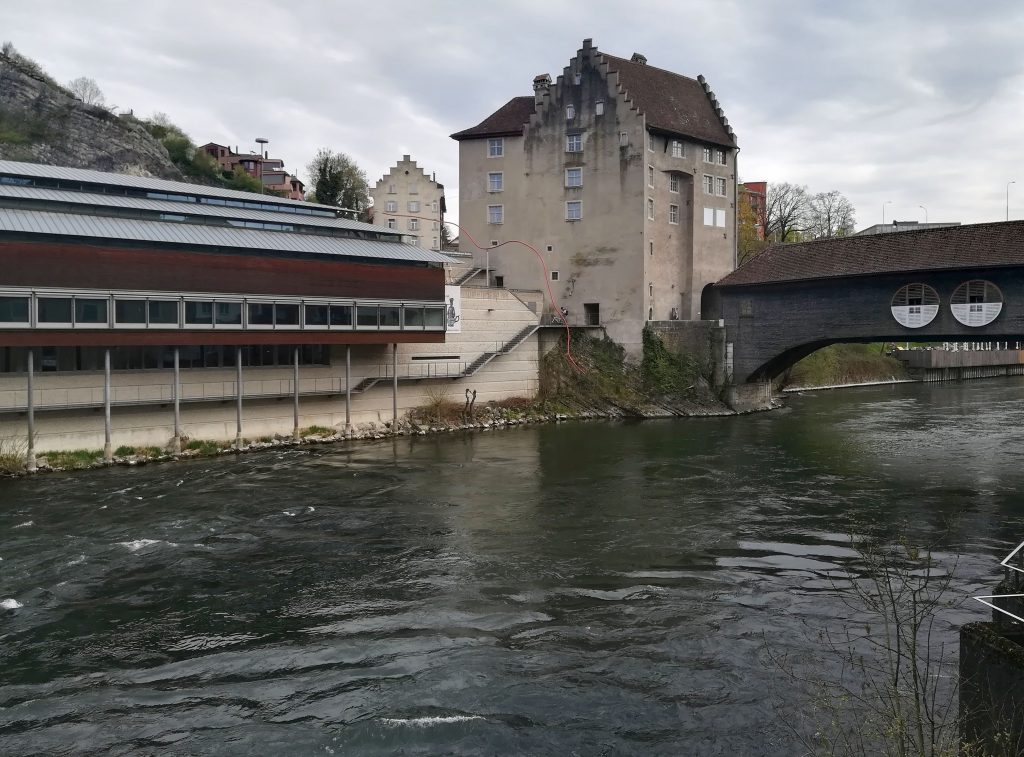
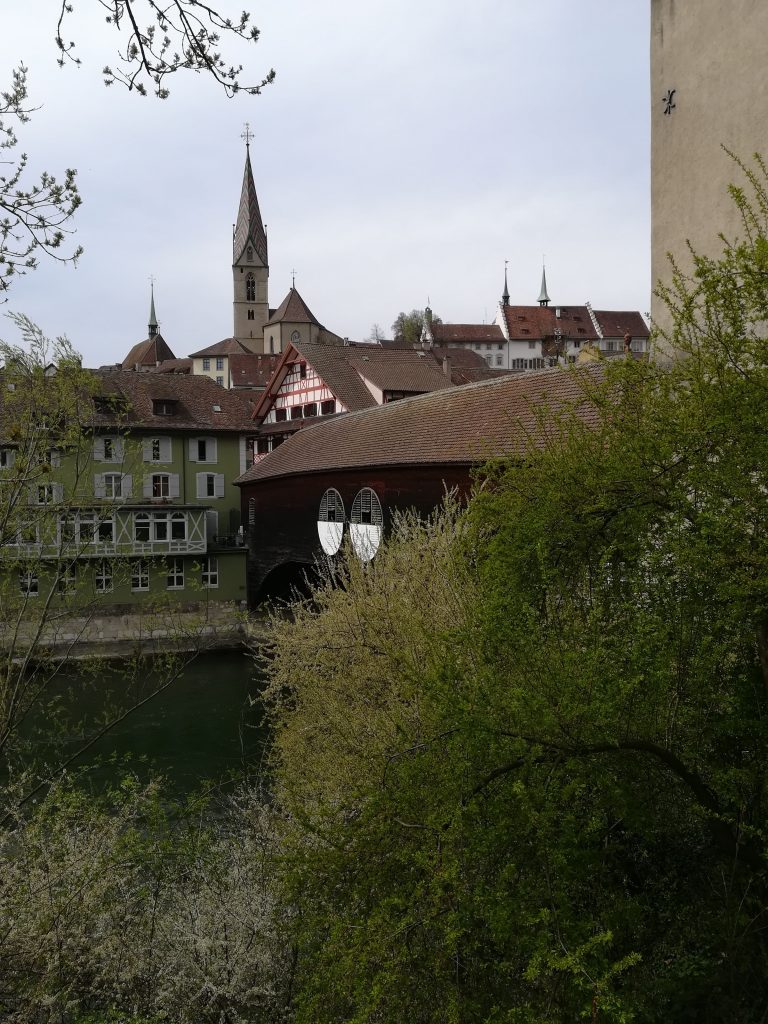
Theaterplatz
This is rectangular in shape. Three of its four sides are bounded by recent buildings, all of which are elegantly anonymous. The fourth, the view across a steep hillside, is open. In the gaps left by the trees, white houses hasten their climb to the top. Walking towards the edge, we finally apprehend the fourth façade that defines the square: the day-by-day emptiness carved out by a stubborn river. Riverside trees and steep roofs take root below us. The tiny historic centre, rising behind the now absent wall, shows us the way ahead with the slopes of its roofs. On the opposite bank, the Historisches Museum Baden looks out over the Limmat, resting on slender, light metal supports. Its firmness in defining the river ledge seems eternal, although its modern construction belies this without hesitation. The façade, made of horizontal slats of wood dulled by time, absorbs the humidity of the last passing rains. The metal roof effortlessly holds back its shine as it waits for the sun to finally decide to come out. The horizontality of its body, lying serenely watching the churning water course, contrasts with the verticality of the adjacent medieval keep, drawing a dynamic composition. Next to them is the Holzbrücke, an extraordinary wooden bridge dating from the 13th century, more than seven hundred years between the bridge and the museum. Thus, side by side, they do not seem so different: either in slats or in thin trapezoidal scales, they wear their already darkened wooden suits. They are just constructions harbouring in their skin and bones the irreversible passage of time. As we leave the cornice, a bustle of people newly incorporated into the mature day brings us back to the city.
Ésta tiene trazado rectangular. Tres de sus cuatro lados están delimitados por construcciones recientes, todas ellas de un elegante anonimato. El cuarto, la visión al frente de una empinada ladera de monte, está abierto. En los intersticios que dejan los árboles, casas blancas se apresuran en su escalada hasta la cima. Caminando hacia el extremo, aprehendemos al fin la cuarta fachada que define la plaza: el vacío día a día excavado por un obstinado río. Árboles de ribera y tejados empinados se arraciman bajo nosotros. El diminuto centro histórico, surgido tras la ahora ausente muralla, nos indica con las pendientes de sus cubiertas el camino a seguir. En la orilla opuesta, el Historisches Museum de Baden se asoma sobre el Limmat, apoyándose sobre unos soportes metálicos de una esbelta ligereza. Su firmeza a la hora de definir la cornisa del río se antoja eterna, aunque su factura moderna lo desmiente sin titubear. La fachada, de listones horizontales de madera apagada por el tiempo, absorbe la humedad de las últimas lluvias pasajeras. La cubierta metálica contiene su brillo con esfuerzo a la espera de que el sol se decida finalmente a salir. La horizontalidad de su cuerpo, que yace sereno observando el curso agitado de agua, contrasta con la verticalidad del torreón medieval adyacente, dibujando una dinámica composición. Junto a ellos, el Holzbrücke, extraordinario puente de madera del siglo XIII. Más de setecientos años separan la construcción de puente y museo. Así, uno junto al otro, no parecen tan distintos: bien en listones, bien en finas escamas trapezoidales, lucen sus trajes de madera ya oscurecida. Son solo construcciones albergando en su piel y huesos el irreversible paso del tiempo. Al abandonar la cornisa, un bullicio de gentes recién incorporadas al día ya maduro nos trae de vuelta a la ciudad.
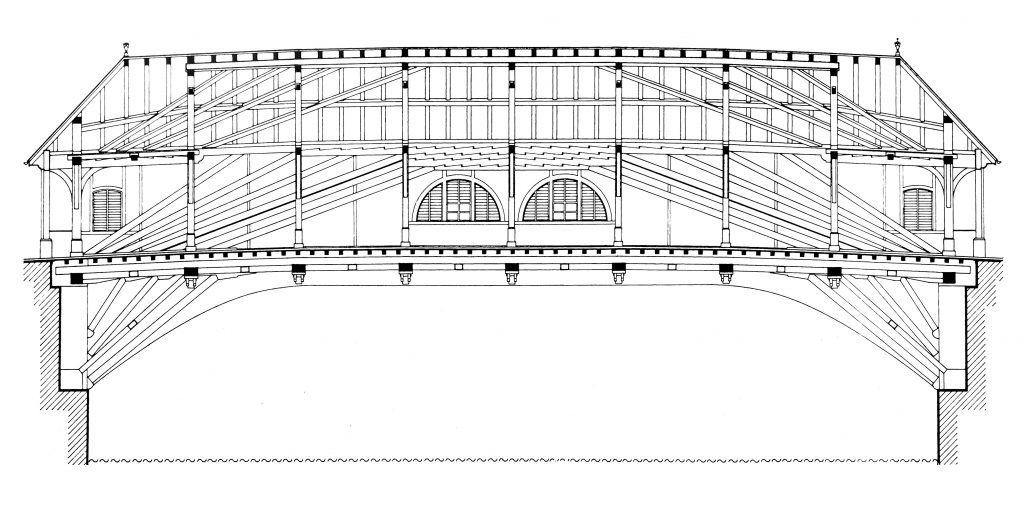
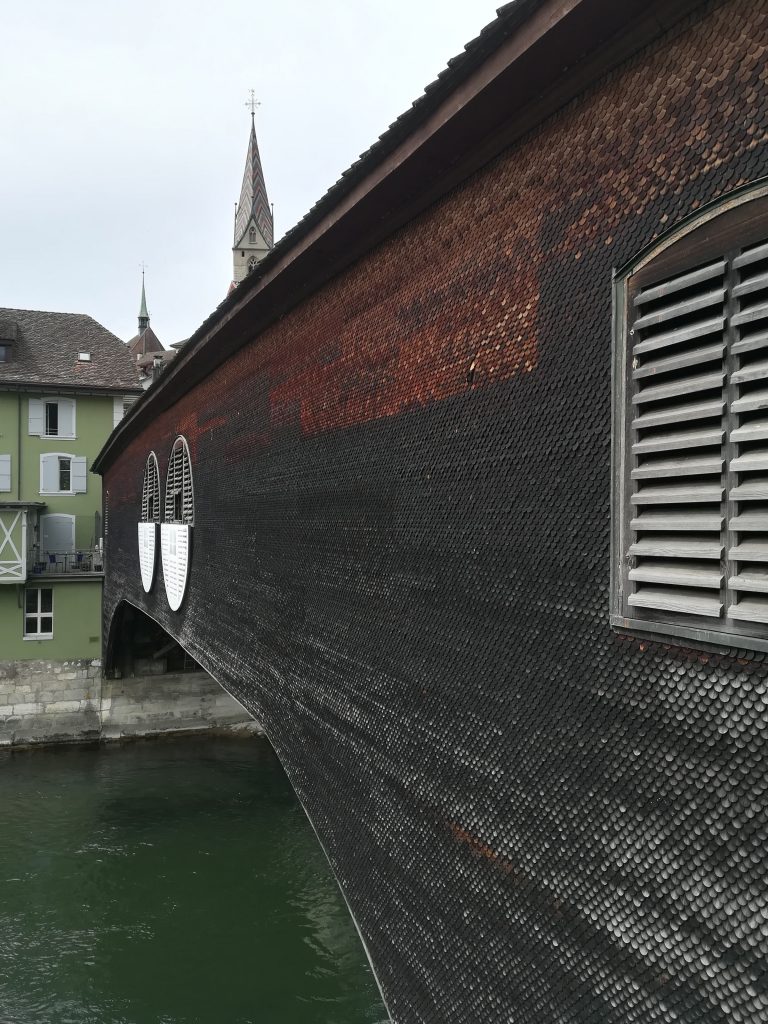
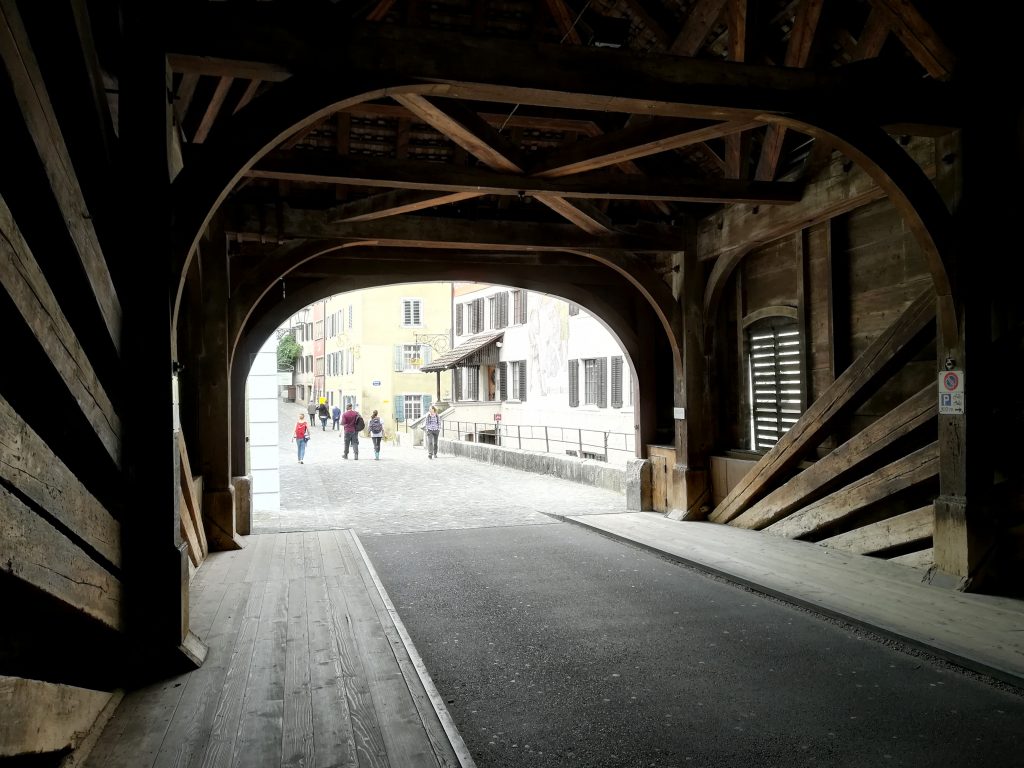

Stadtturm
Going through gates. To build bridges. Through some doors you go out, through others you come in. Some have an ambiguous character that makes them versatile in their use. Passing through them can be the beginning of a ritual journey. The Stadturm tower, absorbed into the urban fabric of Baden, has lost all meaning. People circulate through it indistinctly, it is part of the public space itself. For us today, walking down it means travelling into the time and history of the city. The buildings that surround us take on a stronger personality with every step we take, vestiges of the era in which they were built. Their stucco façades are sometimes of varying earthy tones, sometimes bluish. Holes of different sizes are framed with masonry of varying sizes. The access to the old bridge is somewhat reminiscent of the Stadturm, its volume resembling the negative of the void left by our passage over it. Perhaps it is its falsework, a wooden structure that served as a temporary support for the stone one. A middle-aged couple drink coffee at a tiny table. She keeps her gaze fixed on the bell tower of the Maria Himmelfahrt church; he glances at the menu without disguising his reluctance.
Atravesar puertas. Tender puentes. A través de unas puertas se sale, a través de otras, se entra. Algunas presentan una ambigüedad de carácter que las dota de una polivalencia de uso. Pasar por ellas puede suponer el inicio de un recorrido ritual. La torre de Stadturm, absorbida por el tejido urbano de Baden, ha perdido todo su significado. La gente circula a través de ella indistintamente, forma parte del propio espacio público. Hacerlo en sentido descendente significa, hoy para nosotros, viajar al interior del tiempo y la historia de la ciudad. Las edificaciones que nos rodean adquieren a cada paso una personalidad más fuerte, vestigios de la época en que fueron construidas. Sus fachadas de estuco presentan variados tonos terrosos unas veces, azulados otras. Huecos de diferente tamaño se enmarcan con piezas de mampostería de diversa talla. El acceso al viejo puente recuerda de alguna manera al paso por Stadturm, pareciendo su volumen el negativo del vacío que nuestro paso dejó por ella. Sea quizá su cimbra, estructura de madera que sirvió de soporte temporal a aquella de piedra. Una pareja de mediana edad toma café en una minúscula mesa. Ella mantiene fija su mirada sobre el campanario de la iglesia de Maria Himmelfahrt; él ojea el menú sin disimular su desgana.
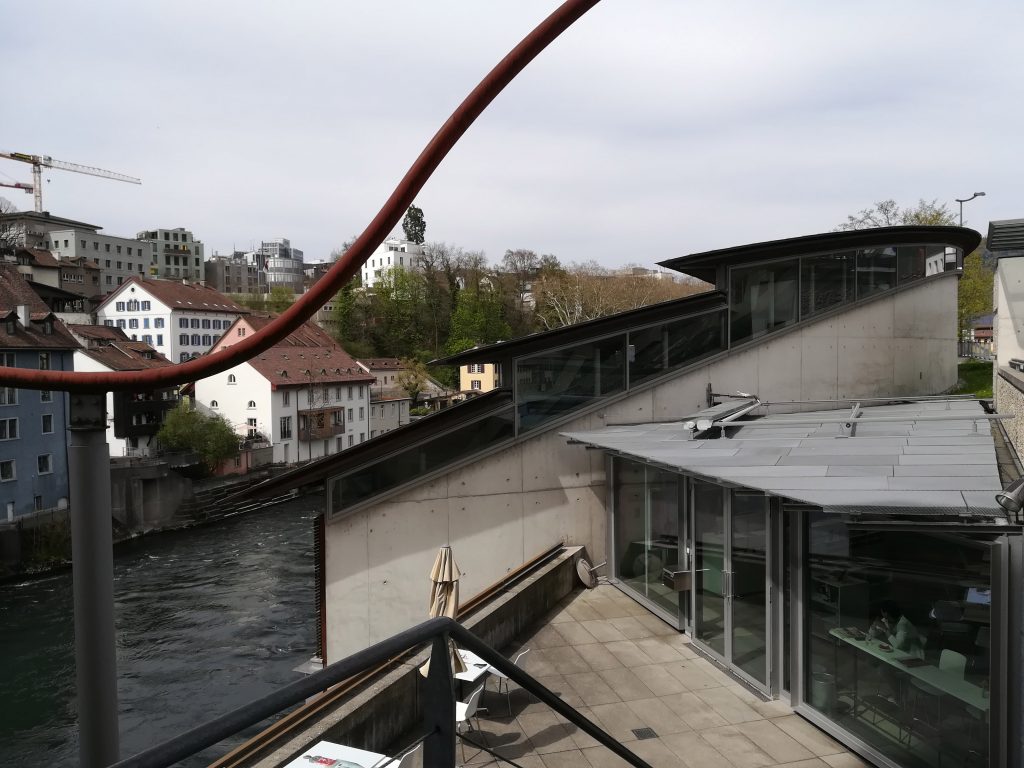
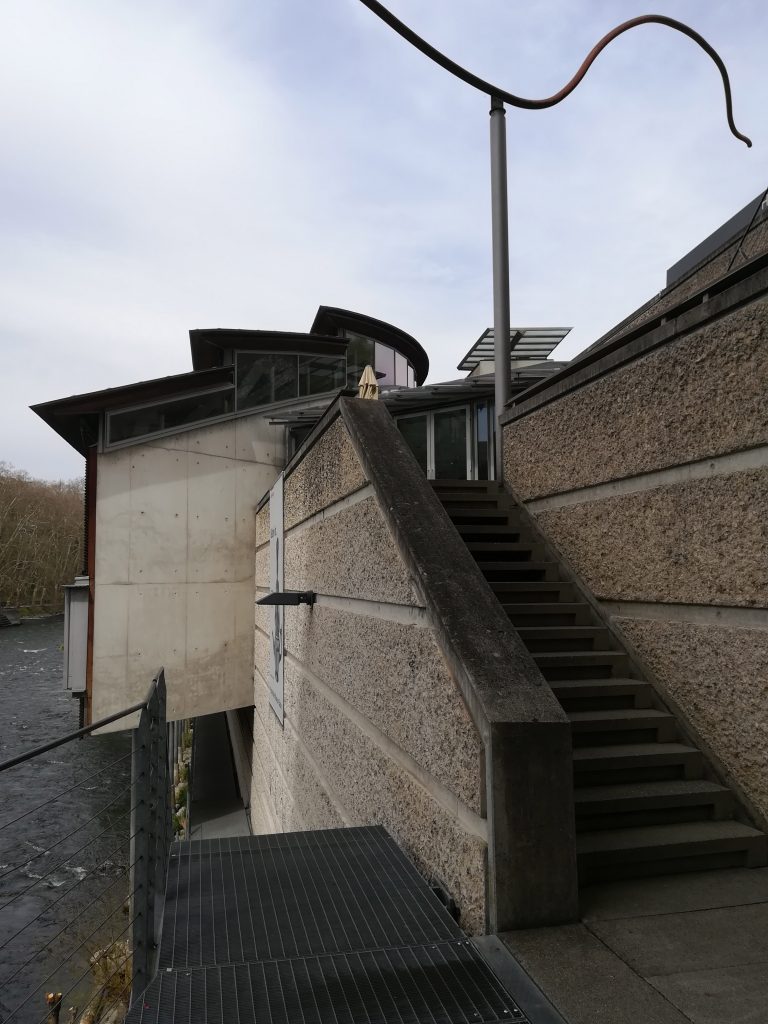
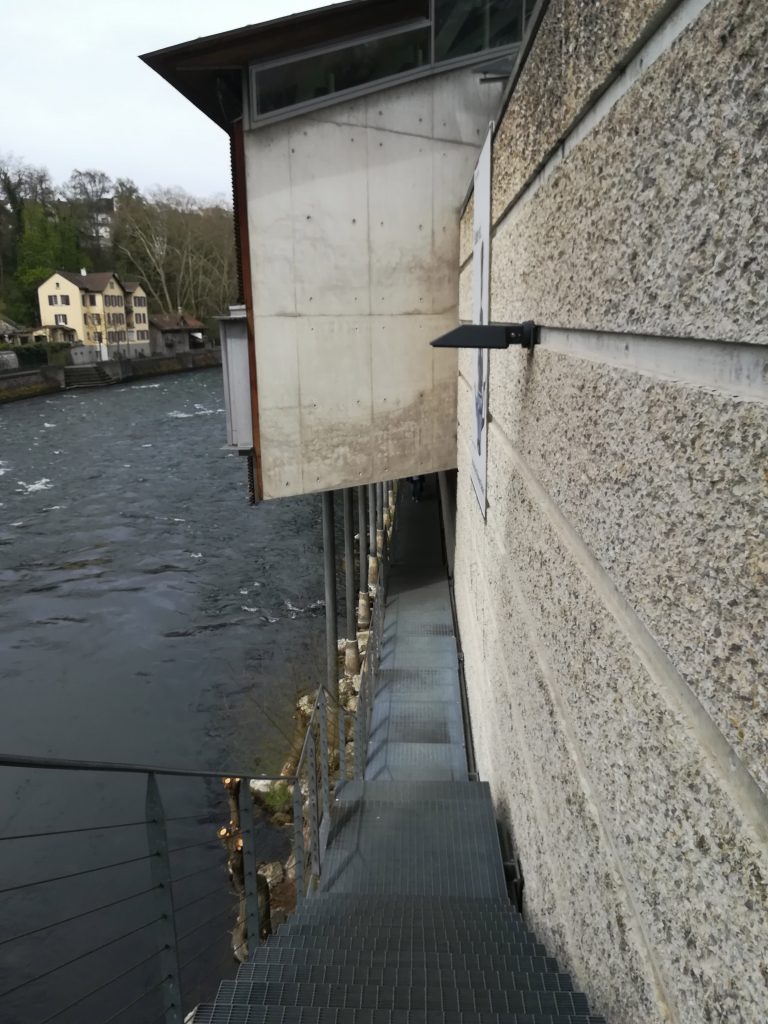
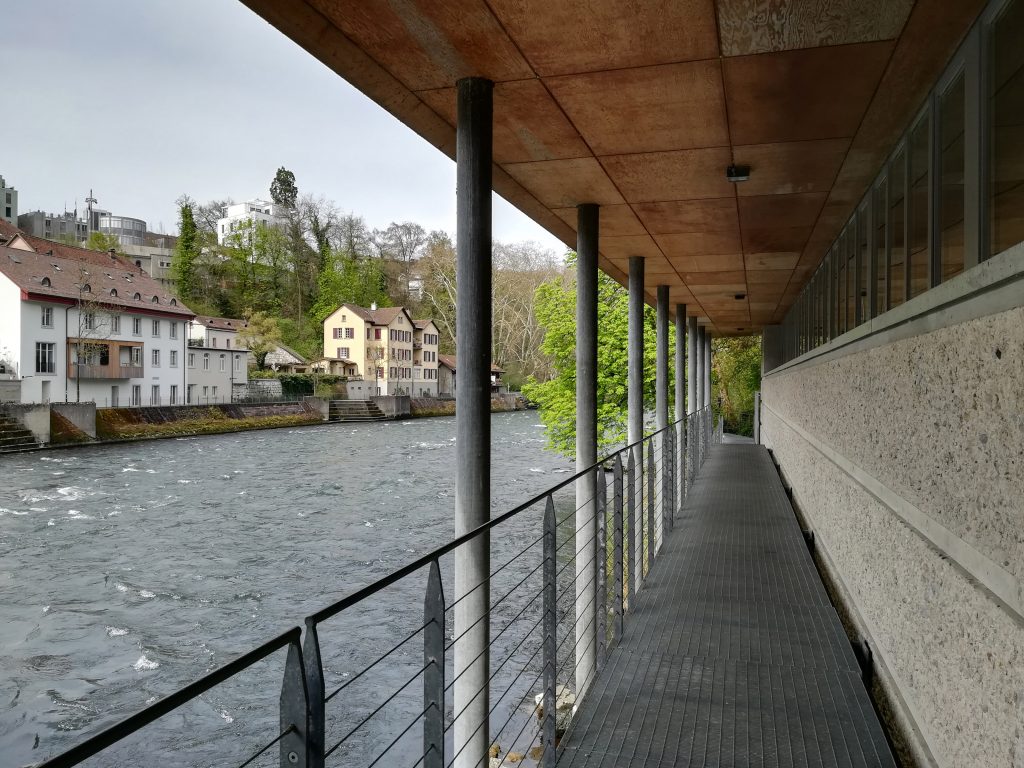
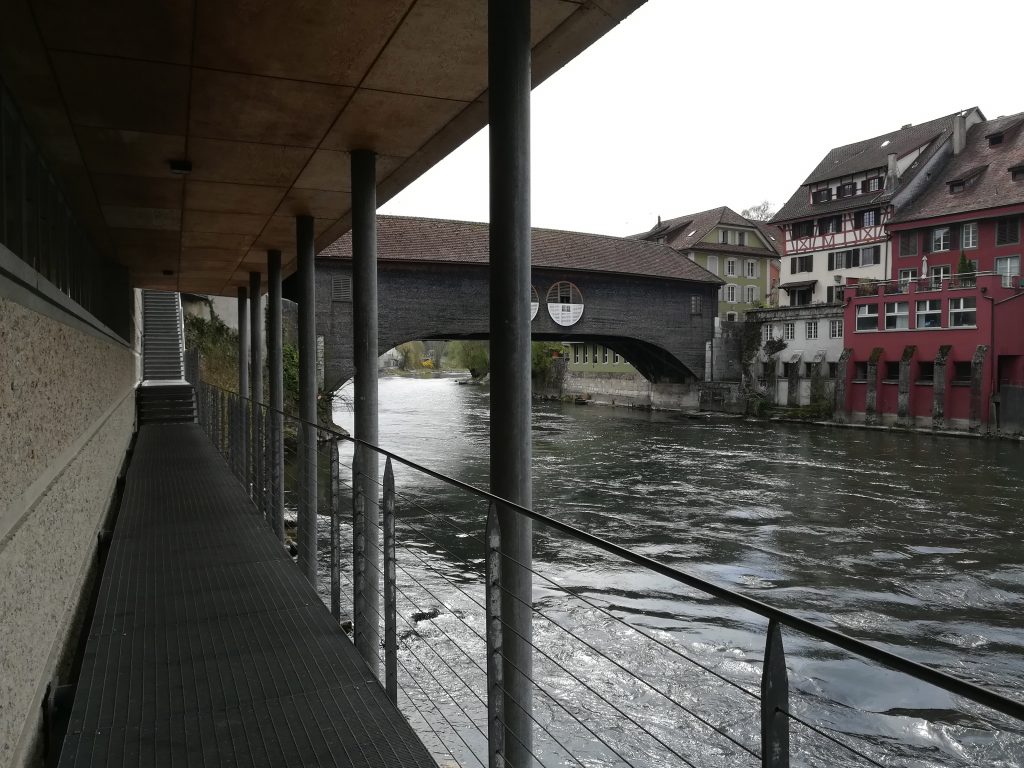
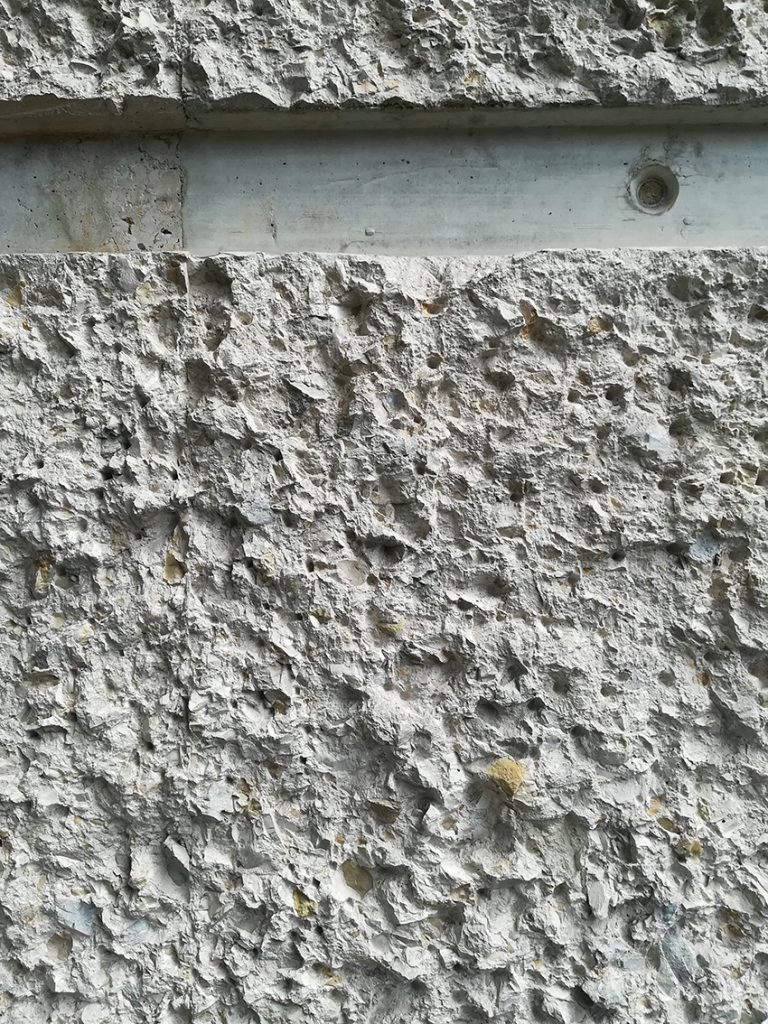
Holzbrücke
The old bridge is adorned with an armour of fine wooden scales. The sunlight filtered through the clouds reflects on the waters of the river to finally give this skin a special glow. The Limmat flows down the river, fed by snowmelt from the peaks. Although it is not a river with a large flow, it demands our attention with the roar it leaves behind as it passes through this city, slowly dragging the earth from the bottom of its bed.
El viejo puente viste engalanado una armadura de finas escamas de madera. La luz del sol filtrada a través de las nubes se refleja en las aguas del río para, finalmente, otorgar a esta piel un brillo particular. El Limmat baja agitado, alimentado por el deshielo de las cumbres. A pesar de no ser un río de caudal importante, reclama nuestra atención con el rugido que deja a su paso por esta ciudad, arrastrando lentamente la tierra del fondo de su cauce.
Entering the bridge means crossing the threshold of transition between light and shadow; in another era between the security of the walled city and the risk of the open countryside. Wooden scales and, behind them, the imposing turret that serves as a historical support for the Historisches Museum.
El ingreso al puente supone atravesar el umbral de transición entre luz y sombra; en otra época entre la seguridad de la ciudad amurallada y el riesgo del campo abierto. Escamas de madera y, tras ellas, imponente el torreón que sirve de apoyo histórico al Historisches Museum.
Wearing a yellow dress with floral patterns, she poses a little shyly as the photographer tries to capture her best smile. After crossing a sometimes deserted city, it is surprising to find this scene here, dark and damp. The wooden frame of the bridge is shown inside, now freed from its suit of scales, in all its expressiveness. In the central part there are two openings on either side, a halo of light is streaming in with determination. Outside, the sun has risen. Through the north-facing openings we see the new museum building, an extension of the bridge we are now crossing. After having seen it from the top of the city, in the theatre square, we had not seen it again, with its wooden slatted façade, its long horizontal window. Through this opening we are not able to take in the whole of its volume with our eyes. Its façade only makes sense from the other side, where we can see how it rises up to consolidate the eastern ledge of the Limmat River. As we approach it, the museum ceases to be a building and becomes a journey, an interval of time in which water, light and shadow help us to become aware of the geography on which Baden sits. From the darkness of the wood of the old bridge, we pass a stone threshold, already under the tower, which turns to the left and brings us back to the river. The city in front of us, and also the sun. Half-timbered facades, plaster and wood, the church bell tower on top, now define the urban cornice. On a corner in the sun, several bags of clothes and pairs of shoes lie forgotten, scattered on the pavement. The girl who is now smiling as she poses, getting more and more comfortable, will return to change more than once before the end of the session.
Luciendo un vestido amarillo de estampados florales, posa con algo de timidez mientras el fotógrafo trata de capturar en imagen su mejor sonrisa. Después de atravesar una ciudad a ratos abandonada, sorprende encontrarse con esta escena aquí, lugar oscuro y húmedo. El armazón de madera del puente se muestra en su interior, ya liberado de su traje de escamas, con toda su expresividad. En la parte central hay dos aperturas a cada lado, un halo de luz se cuela con decisión. Fuera ha salido el sol. A través de los huecos que miran a norte vemos el edificio nuevo del museo, es una extensión de este puente que ahora cruzamos. Después de haberlo avistado desde lo alto de la ciudad, en la plaza del teatro, no habíamos vuelto a encontrarnos con él, con su fachada de listones de madera, su larga ventana horizontal. A través de esta apertura no somos capaces de abarcar por completo con la vista su volumen. Su fachada solo tiene sentido desde la otra orilla, donde se percibe cómo se levanta para consolidar la cornisa oriental del río Limmat. A medida que nos acercamos, el museo deja de ser un edificio para ser un recorrido, un intervalo de tiempo en el cual agua, luz y sombra nos ayudan a tomar conciencia de la geografía sobre la que Baden se asienta. Desde la oscuridad de la madera del viejo puente, pasamos a un umbral de piedra, ya bajo la torre, que girando hacia la izquierda nos devuelve frente al río. La ciudad delante, también el sol. Fachadas entramadas, revoco y madera, el campanario de la iglesia en lo alto, definen ahora la situación de cornisa urbana. En una esquina al sol, descansan olvidadas varias bolsas de ropa y pares de zapatos dispersos sobre la acera. La chica que ahora sonríe mientras posa, va cogiendo soltura, volverá para cambiarse en más de una ocasión antes de acabar la sesión.
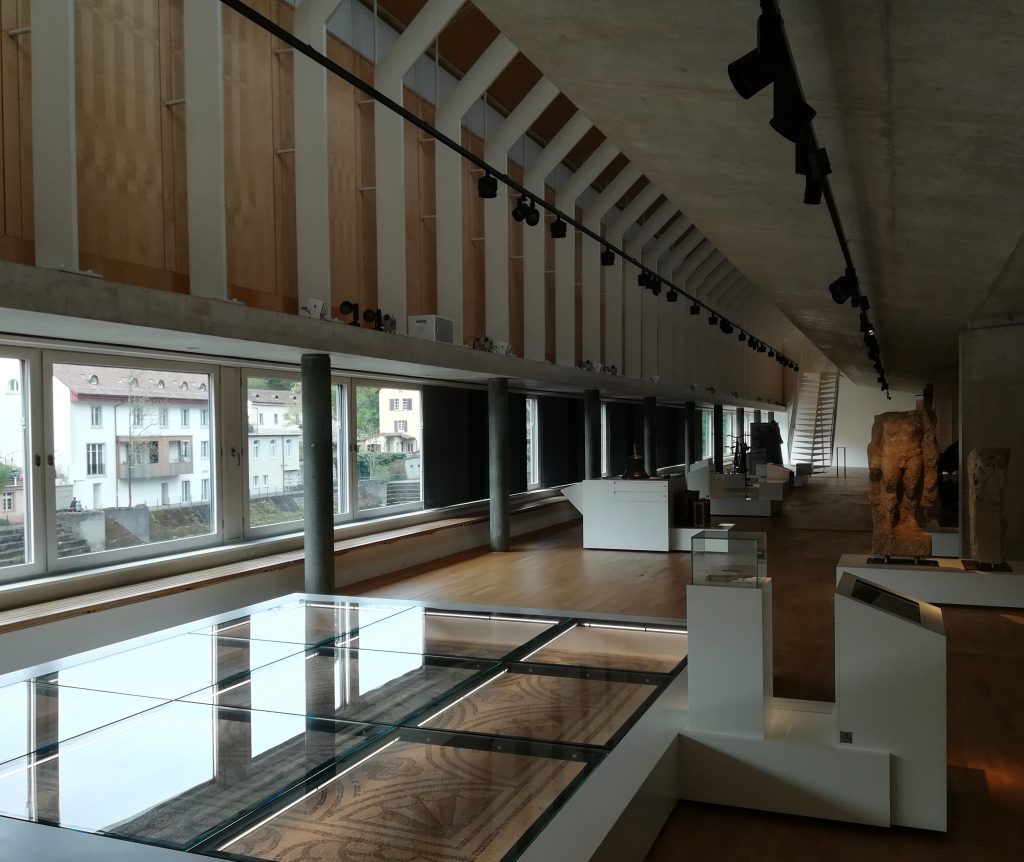
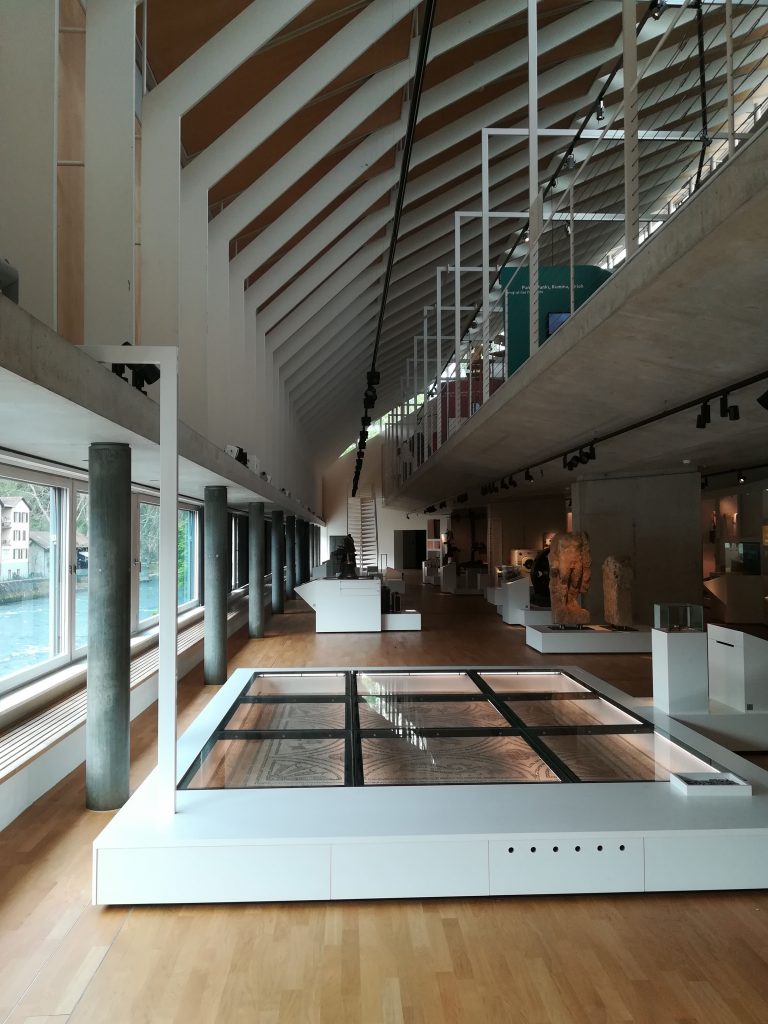
Limmat
We are now standing under the slender supports that raise the museum above the river. Stroll along the ledge, along the edge excavated by perseverance and insistence. Time. The Historisches Museum in Baden has a curious entrance portico. This one, turned towards the city and the river Limmat, its waters lapping under our feet, does not lead to the entrance of the building. Rather, it has the opposite function: to dissuade us, coming from the old wooden bridge, from entering it. The building itself thus tells us that what is important, what is valuable in a programme that aims to explain the history of Baden, lies precisely in going outside and touring the city itself. We had a choice, it was easy. Some stairs went down, towards the water and its glints of sunshine, a tamed riverside forest in the background, while others went up towards the space overshadowed by the tower. After enjoying this moment of distraction, we retraced our steps to climb up to the entrance. Some birds, like early morning swallows in this lazy springtime, draw in the air in an impossible pirouette. They end up resting on a projection of the concrete wall that consolidates the base of the building. It is a heavily bush-hammered concrete; the aggregate, of a different colour, exposed to view, burst. From a distance it looked like some kind of sandstone rock, perhaps washed downstream.
Nos encontramos ahora bajo los esbeltos soportes que levantan el museo sobre el río. Pasear por la cornisa, por el borde excavado a base de tesón e insistencia. Tiempo. El Historisches Museum de Baden construye un curioso pórtico de acceso. Éste, volcado hacia la ciudad y el río Limmat, sus aguas bullen bajo nuestros pies, no conduce hacia la entrada del edificio. Más bien tiene la función contraria: disuadirnos, viniendo desde el vetusto puente de madera, de entrar en él. El propio edificio nos cuenta así que lo importante, lo valioso de un programa que tiene como objetivo explicar la historia de Baden, reside precisamente en salir fuera a recorrer la propia ciudad. Tuvimos elección, fue fácil. Unas escaleras bajaban, hacia el agua y sus destellos de sol, un domesticado bosque de ribera al fondo, mientras que otras subían hacia el espacio ensombrecido por la torre. Después de disfrutar de este momento de distracción, desandamos nuestro camino para, ahora sí, ascender hacia el ingreso. Unos pájaros, parecen golondrinas madrugadoras en esta primavera perezosa, dibujan en el aire en una pirueta imposible. Terminan por apoyarse en un saliente del muro de hormigón que consolida el zócalo del edifico. Es un hormigón fuertemente abujardado; el árido, de diferente color, expuesto a la vista, reventado. Desde lejos parecía algún tipo de roca arenisca, arrastrada quizá por las aguas río abajo.
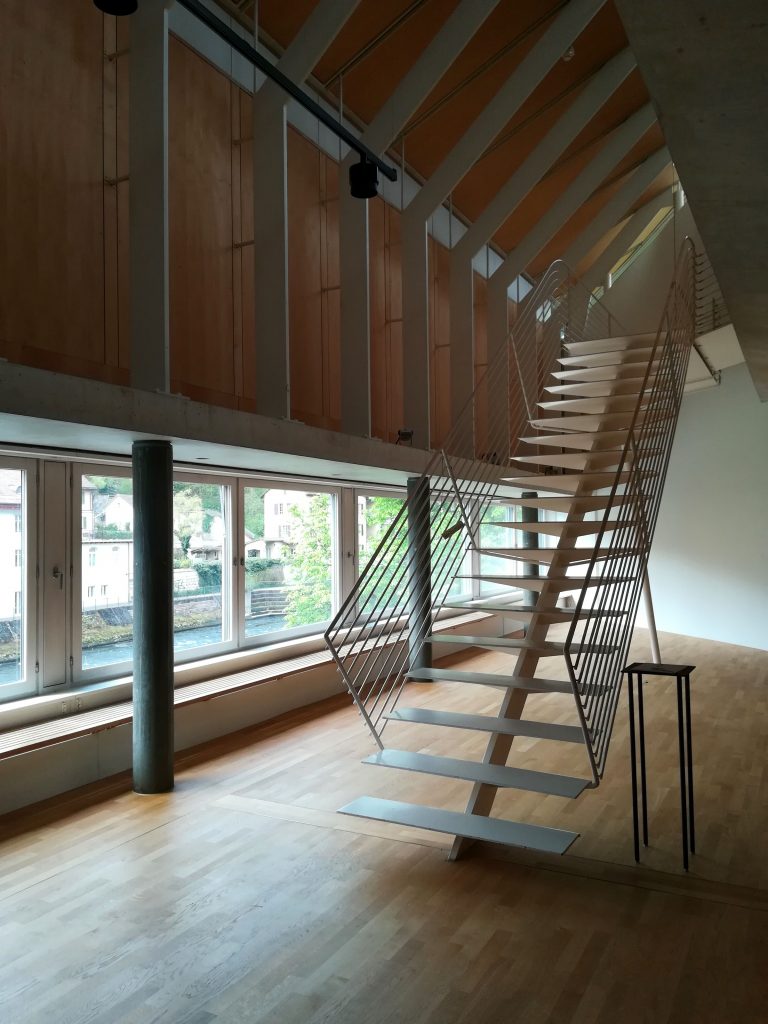
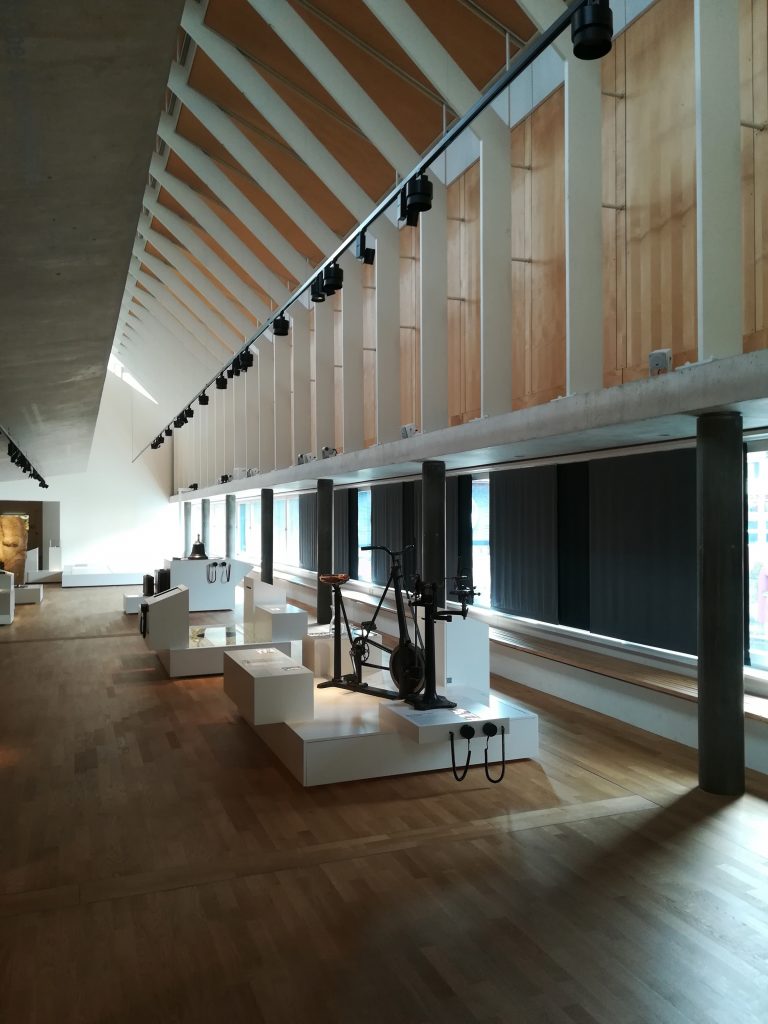
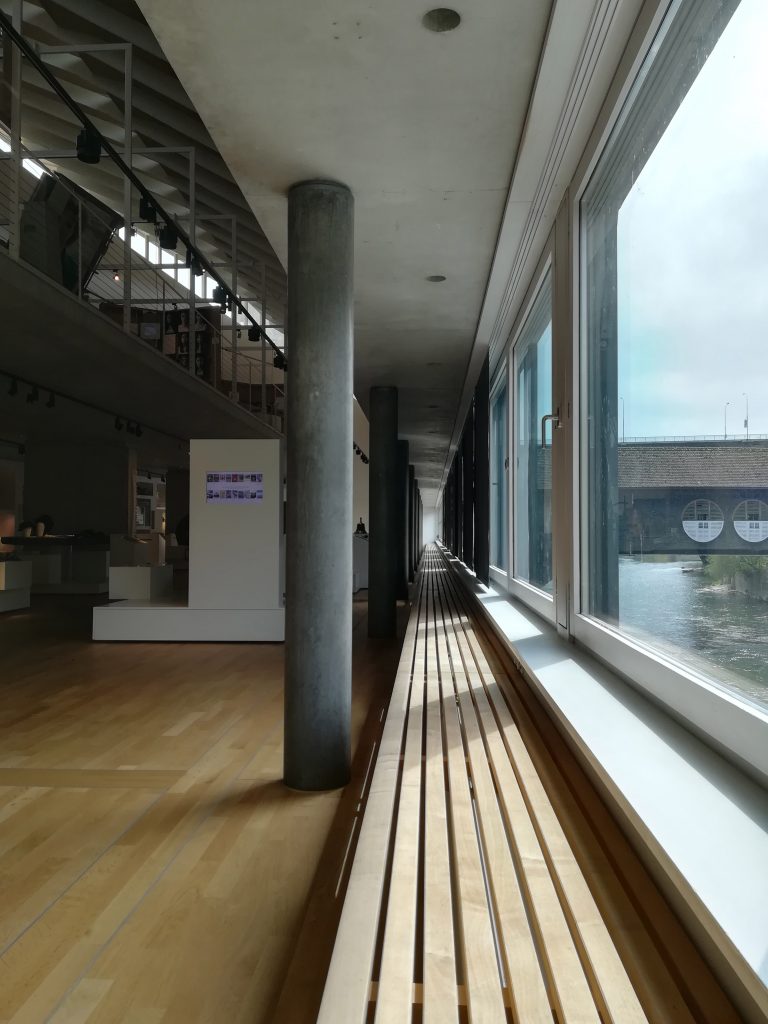
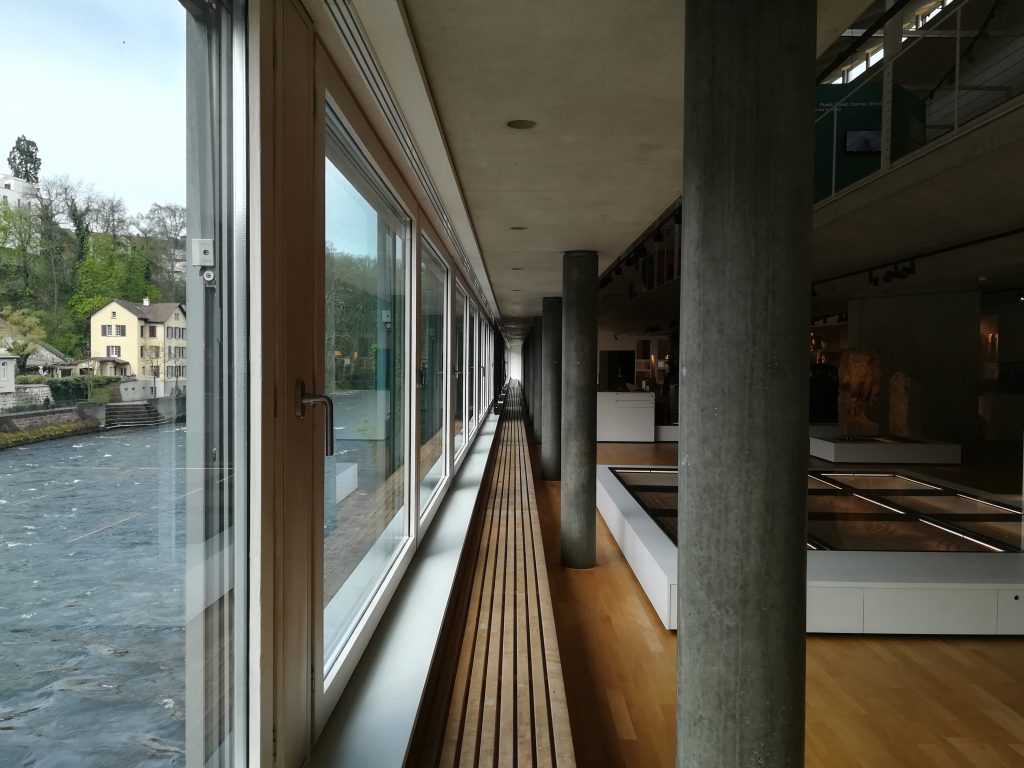
Haupteingang
Worn stone, beaten concrete, swollen wood. In front of them, the shiny, light glass surface that gives access to the museum defines a moment of reflection. The different times present in this place are thus revealed, previously threaded together, in the image reflected sharply on the door. The real palimpsest that is the city is separated from this other, casual arrangement of objects from different periods, forcibly placed along a linear chronological axis. Dissection.
Piedra desgastada, hormigón golpeado, madera hinchada. Frente a ellos, la superficie brillante y ligera de vidrio que da acceso al museo define un instante de reflexión. Los distintos tiempos presentes en este lugar se desvelan así, antes hilvanados, en la imagen reflejada con nitidez sobre la puerta. El palimpsesto real que es la ciudad se separa de este otro, ordenación casual, que son los objetos de distintas épocas colocados forzadamente siguiendo un eje cronológico lineal. Disección.
The pair of birds is already moving away towards the opposite shore. A lady in a brown coat breaks the visual illusion of the reflective surface as she opens the door and leaves the museum. We cross the border between the urban reality and its projected image to descend a ramp in semi-darkness, whose curved course finally plunges us into the water.
La pareja de pájaros se aleja ya hacia la orilla opuesta. Una señora de abrigo marrón rompe la ilusión visual de la superficie reflectante al abrir la puerta y abandonar el museo. Atravesamos la frontera entre la realidad urbana y su imagen proyectada para descender por una rampa en penumbra, cuya directriz curva nos sumerge finalmente en el agua.
